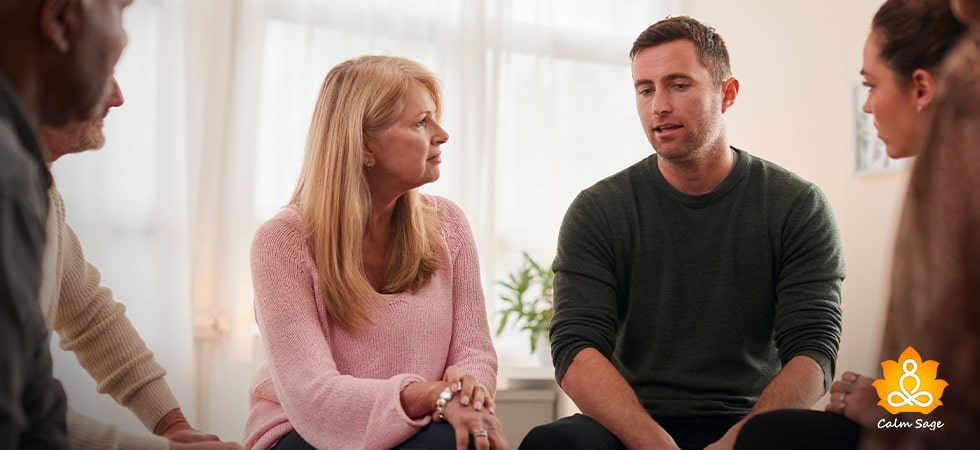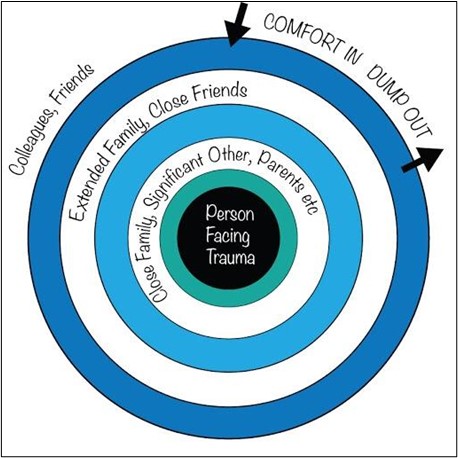Comfort In, Dump Out: Supporting Grief With Ring Theory

“Grief can be a burden, but also an anchor. You get used to the weight, how it holds you in place.” ― Sarah Dessen
Grief is an emotion we all experience differently; it’s the emotion that can be overwhelming, all at once. When you lose a loved one, it’s not only about coping with your emotions but also about offering support and compassion to those who are grieving with you. When it comes to our emotions, we can take care of them, but when it comes to others’ emotions, there’s always a fear of saying something wrong.
The Ring Theory of Grief, also known as the Circle of Grief theory, offers a valuable and powerful insight into understanding this delicate back and forth of grief and support.
This theory, proposed by psychologists Susan Silk and Barry Goldman, provides a simple understanding of offering support and love to those who are grieving or are in a crisis while giving you opportunities to express your emotions and get support in return.
Let’s take a look at what is the ring theory of grief, how it works, and how you offer your support to someone who is grieving.
The Ring Theory of Grief: What Is It?
Imagine a series of concentric circles and in the middle sits grief. The one who’s most affected by the crisis – grief, in our case, is in the center of the circles. The Ring Theory suggests that support and comfort should flow inward – towards the one in the center; the one experiencing grief – and outwards – towards the people who are indirectly affected by the said loss. The rule is simple – Comfort in, Dump out.
But, how does the circle of grief work?
To understand the ring theory of grief, it’s important to acknowledge the emotional distance to the person grieving. Here’s a simple breakdown of the ring theory;

Imgur
In The Center: The One Grieving or Facing Crisis
This is the innermost circle and is reserved for the person who is directly affected by the loss and is grieving. The emotions of the person are the focus. The person in the center of the circle is the one who should receive the most support.
Second Circle: For Closest Friends and Family
The second circle is for the immediate family, close friends, spouse/partner/children, or anyone with an intimate connection with the grieving one. The support should flow inward – towards the center – and outwards to those less affected by the loss.
Third Circle: For Extended Friends and Family
In the third circle, you can find relatives, colleagues, and distant friends who hold a meaningful connection but are not as close. Here, the support flows from the outer rings towards the center of the circles.
Outer Circle: For Acquaintances
The last ring is reserved for acquaintances and others in the life of the person directly affected by the loss. The support mainly flows inwards, respecting the emotional distance of the grieving one.
The placing of the rings is done based on the stages of grief. The people closest to the center might need comfort and even opportunities to express how they feel.
This is where, “comfort in, dump out” comes in; meaning that support should go to the people in the inner circle, while venting of emotions such as fear, denial, and worry should go to the ones in the outer rings.
How to Offer Grief Support?
Now that you know how the ring theory of grief works, let’s take a look at the ways you can offer support and comfort to the ones affected by the loss;
1. Be an active listener:
Sometimes, all you can do to support a grieving person is to listen to them without offering unsolicited advice or making judgments. Just offer a comforting presence and let them talk about their feelings.
2. Be practical:
Especially when you’re offering help, be practical and pragmatic. Simple acts of kindness can go a long way in supporting the grieving one. You can offer to run their errands, cook a meal for them, or help them with their daily tasks, just to ease some of their burden.
3. Check-in with them:
Grieving is a unique process; it doesn’t have a timeline. Make it a habit to check in with the grieving one to show your support and compassion to them.
4. Be thoughtful:
You can show your support by sending your loved one flowers, cards, or small gifts to let them know you’re thinking of them. Sometimes reminding your loved one that they are not alone can go a long way to show support during times of grief.
5. Respect the grieving process:
We all have different ways to grieve, so be patient and respectful of the grieving process, no matter how different it is from yours. Grieving is a unique experience, so avoid being judgmental and pressure the grieving person to “move on”.
What To Avoid?
Support is important, but it’s more important to be mindful of some things so that you don’t cause more hurt to the person at the center of the grief;
1. Avoid comparing the loss:
You need to avoid saying things like, “I know how you’re feeling” or oversharing your grief stories. You need to respect the person’s grief and loss, so don’t try to invalidate their emotions.
2. Don’t offer unsolicited advice:
While advice can be well-intentioned, unsolicited advice can become overwhelming. Instead of offering advice, try to listen and let the other person guide the conversation.
3. Avoid clichéd phrases:
Don’t say phrases that are too clichéd, such as, “It all happens for a reason” While you might not mean it that way, these phrases can invalidate the other person’s loss instead of offering support.
4. Don’t disappear:
Grieving people might ask for time alone, but you should not disappear from their lives entirely. Sudden isolation can be dangerous. Try to keep a distance but maintain a connection with them.
Wrapping Up…
The Ring Theory of Grief provides a simple but compassionate framework to help us understand the complexities of emotions surrounding loss. Supporting someone when they are grieving is not about saying the right things; it’s about being present in their lives and offering support and comfort. Supporting a grieving person is about understanding the emotional distances and giving comfort in ways that respect the grief journey.
Grief is a natural and universal experience that needs collective understanding and empathy. Understanding grief support with the ring theory can create a supportive network that can help your loved ones cope with loss while encouraging a sense of community, kindness, and comfort.
Did this ring theory of grief help you understand grief support? Do you agree with this theory of grief support? Let me know your thoughts about the act of supporting a grieving loved one in the comments below.
Take Care!




















